CHINESE MILITARY
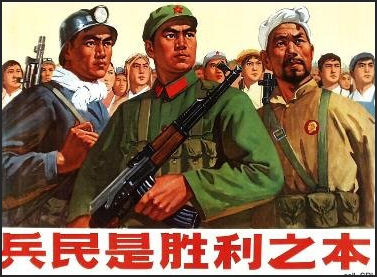 The Chinese military is known as the People’s Liberation Army (PLA). Defense spending: 2.3 percent of Gross National Product (compared to 25.5 percent in North Korea, 3.8 percent in the United States and 0.6 percent in Ghana). Population in military: .24 percent (compared to 4.6 percent in North Korea and .73 percent in the United States).China has the world's largest armed forces, with 2.3 million troops (1.7 million in the army. 220,000 in the navy and 420,000 in the air force) in 2007. It used to be even larger. In 1994 there were 2,930,000 troops (2.3 million in the army, 250,000 in the navy, 470,000 in the air force), plus 1.2 million reserves. By contrast the United States has 1.45 million troops; Russia, 1.24 million troops; and Argentina, 65,000 troops. About 35 percent of the Chinese defense budget is spent on personnel costs.
The Chinese military is known as the People’s Liberation Army (PLA). Defense spending: 2.3 percent of Gross National Product (compared to 25.5 percent in North Korea, 3.8 percent in the United States and 0.6 percent in Ghana). Population in military: .24 percent (compared to 4.6 percent in North Korea and .73 percent in the United States).China has the world's largest armed forces, with 2.3 million troops (1.7 million in the army. 220,000 in the navy and 420,000 in the air force) in 2007. It used to be even larger. In 1994 there were 2,930,000 troops (2.3 million in the army, 250,000 in the navy, 470,000 in the air force), plus 1.2 million reserves. By contrast the United States has 1.45 million troops; Russia, 1.24 million troops; and Argentina, 65,000 troops. About 35 percent of the Chinese defense budget is spent on personnel costs.
According to 2006 and 2007 Pentagon reports, China still had limited ability to project its military strength over long distances but among "major and emerging powers” it had the “greatest potential to compete militarily” with the United States.
Military Service: 18 to 22 years of age for selective compulsory military service with a 24-month service.
Chinese Military (1997): 5,224 combat aircraft, 110 naval vessels, 9,400 tanks, 300+ nuclear warheads.
Articles on the CHINESE MILITARY factsanddetails.com ; Chinese Military Power www.comw.org ; Chinese Government Site on the Chinese Military chinatoday.com
Military Organization in China
The Chinese military is led by the Central Military Commission. It had 11 members, including a chairman and three vice chairmans and separate leadership positions for the army, navy, air force artillery corps and army forces in different parts of the country, in 2004. The chairman of China’s Central Military Commission is China’s highest ranking officer. The vice chairman of the commission is China’s second highest ranking officer. The chairman has traditionally been the leader of China. The other members are either military men loyal to him or men who have links with other powerful politicians. How the members are selected is a mystery. See More in the Armed Forces Article
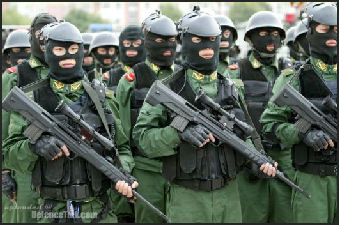 The Chinese military operates beyond civilian control. It is very secretive. Much of what really going on is unknown outsiders. The is some evidence that the military operates and makes plans independently of the Politburo in Beijing.
The Chinese military operates beyond civilian control. It is very secretive. Much of what really going on is unknown outsiders. The is some evidence that the military operates and makes plans independently of the Politburo in Beijing.
In 1998, Jiang announced that he was going to make the Chinese military leaner and meaner by cutting 500,000 soldiers, increasing spending for advanced weapons and reducing lawlessness and corruption and getting the military out if business.
In 2009, military leaders, faced with challenges in Tibet, Xinjiang and from the economic crisis and Tiananmen Square anniversary, asked troops to show “absolute obedience.”
China is making an effort to attract more recruits with university degrees raising the enlistment age to 22 and lowering eye test requirements.
China Becomes More Hardline Militarily in the 1950s
Militancy on the domestic front was echoed in external policies. The "soft" foreign policy based on the Five Principles of Peaceful Coexistence to which China had subscribed in the mid-1950s gave way to a "hard" line in 1958. From August through October of that year, the Chinese resumed a massive artillery bombardment of the Nationalist-held offshore islands of Jinmen (Chin-men in Wade Giles but often referred to as Kinmen or Quemoy) and Mazu (Ma-tsu in Wade-Giles). This was accompanied by an aggressive propaganda assault on the United States and a declaration of intent to "liberate" Taiwan. [Library of Congress]
The Sino-Soviet dispute of the late 1950s was the most important development in Chinese foreign relations. The Soviet Union had been China's principal benefactor and ally, but relations between the two were cooling. The Soviet agreement in late 1957 to help China produce its own nuclear weapons and missiles was terminated by mid-1959. From that point until the mid-1960s, the Soviets recalled all of their technicians and advisers from China and reduced or canceled economic and technical aid to China. The discord was occasioned by several factors. The two countries differed in their interpretation of the nature of "peaceful coexistence." The Chinese took a more militant and unyielding position on the issue of anti-imperialist struggle, but the Soviets were unwilling, for example, to give their support on the Taiwan question. In addition, the two communist powers disagreed on doctrinal matters. The Chinese accused the Soviets of "revisionism"; the latter countered with charges of "dogmatism." Rivalry within the international communist movement also exacerbated Sino-Soviet relations. An additional complication was the history of suspicion each side had toward the other, especially the Chinese, who had lost a substantial part of territory to tsarist Russia in the mid-nineteenth century. Whatever the causes of the dispute, the Soviet suspension of aid was a blow to the Chinese scheme for developing industrial and high-level (including nuclear) technology.
Chinese Military Strategy and Goals
China maintains its army is strictly for self-defense but build ups indicate it is preparing itself to handle regional conflicts such as disputes over resources or territory and increasing its ability to project itself far beyond its borders. In the mid 2000s, however, analysts became increasingly concerned by China’s military build up and it impact on the balance of power in Asia. China was viewed increasingly as not only a threat to Taiwan but also a threat to U.S. forces in the region and countries involved in territorial disputes with China such as Japan, India, the Philippines and Vietnam.
China is trying to leap frog from second-rate military power to a modern fighting force by developing sophisticated missiles and nuclear weapons. But according to the Pentagon the Chinese military is "still decades away from possessing a comprehensive capability to engage and defeat a modern adversary beyond China's boundaries." The Chinese military has improved its image at home by in the relief of floods and other natural disasters.
Elements of the Chinese military are focused on a potential confrontation with Taiwan. According to the 2010 Pentagon report: “The People’s Liberation Army is developing the capability to deter Taiwanese independence or influence Taiwan to settle the dispute on Beijing’s terms while simultaneously attempting to deter, delay or deny any possible U.S. support of the island in case of conflict.” According to a Rand Corp. report issue in August 2009, a Chinese missile attack on Taiwan could “cut every runway at Taiwan’s half-dozen main fighter bases and destroy essentially all of the aircraft parked on ramps, allowing China to dominate the skies of Taiwan.”
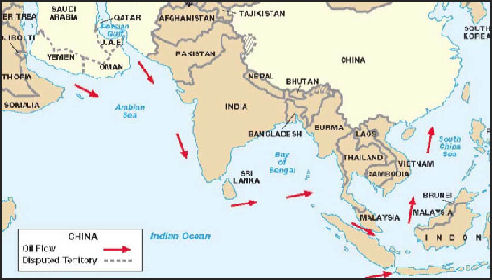
Critical sea lanes
China is also reported to be building an antiship ballistic missile base in southern China’s Guangdong Province, with missiles capable of reaching the Philippines and Vietnam. The base is regarded as an effort to enforce China’s territorial claims to vast areas of the South China Sea claimed by other nations, and to confront American aircraft carriers that now patrol the area unmolested. Some analysts see “China’s ongoing anti-piracy mission in the Gulf of Aden is arguably the first step in overseas military deployments to protect PRC citizens working overseas.” [Source: Michael Wines, New York Times, October 2010]
China transports oil on shipping lanes watched over by U.S. military ships. As China becomes increasingly dependent on foreign oil it becomes increasingly important that the shipping lanes through the Malacca Straights remain open.
In the 1980s, China adopted a strategy referred at the “first island chain,” protecting waters within a line of islands that run from south of Okinawa to Taiwan to the Philippines. After the. 1996 confrontation with U.S. Navy in the Taiwan Straits in 1996 it adopted a “second island chain” running from the Iwo Jima area southeast of Japan to Guam, far beyond waters claimed by China, to discourage the U.S. Navy from approaching too close to waters claimed by China.
There is a legend about a Chinese general that replenishes his army with arrows by drawing fire to a dummy soldiers.
Chinese Military Threat
According to the 2010 Pentagon report: in 2010: “The limited transparence in China’s military and security affairs enhances uncertainty and increases the potential for misunderstanding and miscalculation.” In a August 2010 report, the Pentagon said China was continually beefing up its military capabilities and was using its powerful navy to aggressively advance in the South China Sea, with particular concerns raised about the Spratly Island and areas claimed by both China and Japan, and highlighted the fact that China is now able to project its naval power into the Indian Ocean.
Drew Thompson of the Nixon Center, a Washington think-tank, told Reuters that the threat presented by China is minimal and that accurately evacuating the threat requires answering some key questions: “What is their readiness level? How effective are these things they’ve developed themselves. Is their indigenous technology really working, or does it simply exist like a lot of things in the Chinese system, on paper?...If you go to the PLA and they show you some fantastic new missile on display at an air show, yes, they have a missile system, but does it work” Does it work repeatedly and does it work in combat conditions.”
Li Dianren, a professor at China’s National Defense University, said “There’s no way China can threaten the United States. Anyone with even a bit of common sense knows that our capabilities do not come even close to matching those of the U.S. In terms of technology and the military, the gap is huge. How can we threaten them.” On top of that the Chinese military has little fighting experience. They haven’t been engaged in a conflict since 1979 when they got their butts kicked by Vietnam.
In a Chinese-language book called “The China Dream”, senior PLA officer Col. Liu Mingfu, said that China should build the world’s strongest military, replace the United States as the global “champion” and not beat around he bush to achieve these goals and “sprint to become world number one.” The books does not represent government policy but the fact it was allowed to be published demonstrates the government doesn’t discourage nationalistic views like that from being aired.
See Cyber Warfare

Chinese Military Conflicts
Mao once said: “Fight no battle you are not sure of winning.” China’s record in conflicts however does not bear this out.
1952: China was involved in Korean War. See Creation of Communist China, China Under Mao, History
1958: China bombarded Taiwan's Quemoy and Matsu islands. See Taiwan
1962: China was involved in border dispute with India in the Himalayas. See India, Greater China and Asia, International
1963-64: China and Soviet Union split. See Russia, Russia, Europe, and Asia, International
1969: China clashed with Soviet Union on a disputed border, See Russia, Russia, Europe, and Asia, International
1979 China faired disastrously in a 16-day war with Vietnam. Military improved since disastrous performance against Vietnam. See Vietnam, Greater China and Asia, International
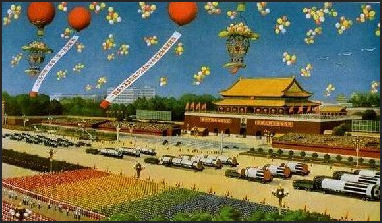
Chinese Military Spending
China spend about $90 billion a year on military spending, roughly double what Japan and Germany spend and one eighth what the U.S. spends. In China, defense spending accounts for 1.4 percent of its GDP compared to 4.8 percent in the United States, and accounts for 6.3 percent of China’s national government spending.
China’s military spending will rise 12.7 percent in 2011 to 583.6 billion yuan, or about $88.6 billion, or about 1.58 times larger than the military budget of Japan. A Chinese official said the increase was not a threat to other countries. The Chinese media reported that much of the money was earmarked for raises for military perosnnel, with some PLA members receiving pay increases of up to 40 percent. [Source: Michael Wines, New York Times, March 4. 2011]
Double digit increases in military spending has occurred for 21 years between 1989 and 2009. It dropped to single digits in 2010 — when spending rose only 7.5 percent, perhaps, analysts said, because money was diverted to address the global economic crisis — then returned to double digits in 2011. Since 1989, the budget has risen by an average of 12.9 percent per year, according to GlobalSecurity.org, a private organization that maintains an online database of military-related information.
The resumption of rapid growth of military spending comes at a time when China’s neighbors have expressed concern about the military’s increasingly muscular behavior in waters off its Pacific coast and along the tense border with India. But the spokesman, Li Zhaoxing, repeated China’s longstanding position that the military is a defensive force and that it “will not pose a threat to any country.”
In March 2010, China announced that defense spending would increase 7.5 percent in 2010, a smaller increase than expected and the first time in two decades the increase was less than 10 percent. Official defense spending increased 18 percent in 2008 to $60 billion and 14.9 percent in 2009 to $70 billion. The U.S. defense department said the true figure is between $115 billion and $160 billion. Defense spending increased at a double digit rate in 2009 for the 21st consecutive year. Spending that year was nearly double the 2005 figure, which in turn was nearly 10 times as high as the 1989 figure.

The defense budget (allocation for the PLA) rose 17.6 percent to $58.76 in 2008. A government spokesman said the money would be used to raise the pay of military personnel, improve training and upgrade military equipment. Many analysts saw the increase as a warning to Taiwan to no not rock the boat. The Chinese military budget is high. But even if it is double what the government says it is still less than a forth of U.S. military budget.
China’s announced military budget was $25 billion in 2004, $29 billion on 2005, $36 billion in 2006 and $45 billion in 2007 (1.35 percent of GNP, compared to 4.03 percent in the United States). Experts say these figures are understated and the real figures are two or three times higher. U.S. intelligence estimated that real military-related spending in 2007 was between $85 billion and $125 billion (1.75 to 3 percent of GDP), making China’s military spending third in the world behind the United States and Russia.
China does not release specifics on spending, weapons purchases or equipment acquisitions. Analysts believe that when unannounced programs are added China’s military spending is several times the announced sum. China spend less per capita on military than Britain, France, Russia or the United States. Military spending of the United States is $400 billion a year. Britain and Japan each spend about $50 billion a year on their militaries.
Over the next decade, China's defense spending is expected to increase while U.S. military spending is expected to decrease. Chinese military spending increased by more than 10 percent annually through the 1980s, 1990s and early 2000s Military spending is expected to keep increasing at that rate and reach $200 billion a year by 2020.
China Plans to Boost Defense Spending by 11.2 Percent in 2012
In March 2012, AP reported: “China's defense spending will see a double-digit increase again in 2012, as strong economic growth continues to fuel rapid military expansion, the country's legislature spokesman said Sunday. Li Zhaoxing said defense spending would increase by 11.2 percent over actual spending last year to hit 670.2 billion yuan ($106.4 billion) in 2012, an increase of about 67 billion yuan. China's official defense spending is the largest in the world after the United States, but actual spending, according to foreign defense experts, may be 50 percent higher, as China excludes outlays for its nuclear missile force and other programs.[Source: Associated Press, March 3, 2012]
Li, speaking at a news conference a day before the opening of the annual session of the National People's Congress, said China's military spending was small as a percentage of gross domestic product compared to other countries, especially the United States. "China is committed to the path of peaceful development and follows a national defense policy that is defensive in nature," Li said. "You see, China has 1.3 billion people, a large territory and long coastline, but our defense spending is relatively low compared with other major countries." Last year's military spending amounted to 1.28 percent of China's economy, Li said. By contrast, the ratio stood at 4.8 percent for the U.S. in 2010, according to the World Bank.
Beijing has mounted a robust defense buildup for more than two decades that has transformed the military into a formidable regional force, increasingly able to project power far from China. While chiefly aimed at the U.S., the buildup is also jangling nerves among Asian rival India and neighbors Japan, Vietnam and the Philippines, which have maritime disputes with China.
With the huge outlays, the Chinese military's armory include the home-built J-10 jet fighter, new nuclear submarines and modern surface vessels armed with supersonic anti-ship missiles. Last year, China began testing a new J-20 stealth fighter and launched sea trials of its first aircraft carrier, a refurbished hulk purchased from Ukraine. Cyber-warfare programs are also burgeoning.
While Beijing insists its military is defensive and is not a threat, defense analysts say the new capabilities are aimed at keeping foreign forces, especially the U.S., out of the seas and air space around China. The South China Sea has become a new potential flash point, with Beijing's more powerful navy and an assertive policy to defend contested claims to groups of islands, reefs and atolls, and the U.S. has declared its own interest in making sure sea lanes remain open.
Growing Chinese power and East Asia's economic importance is driving neighboring countries to boost defense spending and has prompted the U.S. to redirect defense resources to the region. Washington's moves to rotate new troops to Australia, shore up alliances with other traditional allies Japan and the Philippines while forging new military ties to Vietnam has heightened Beijing's fears of encirclement.
Reasons for High Defense Spending
China has said that defense spending increases are necessary to upgrade equipment, improve conditions for soldiers, guard against unrest and make up for shortcoming in the military and slow growth in military spending the past (1.2 percent between 1979 and 1989 and 6.1 percent between 1990 and 1997. China’s Asian neighbors were concerned and said it could set off an arms race.
In October 2009, Chinese general Xu Caihou defending the spending increase, saying the money was need just to meet China’s minimum defense requirements. He said, “We will never seek hegemony, military expansion or an arms race.” The funding is for “a limited capability, and limited weapons and equipment for the minium requirement of its national security.”
Much of China military budget has been spent on modernizing China’s antiquated military hardware. China has only $100 billion of modern military hardware such as Russian-made fighter, submarines and destroyers. (by comparison the U.S. force of B-1 and B-2 bombers alone is worth $50 billion). A lot has been spent on personnel. Although number of troops has dropped the money spent on improving wages, training and living conditions has risen. In 2003, the government said it was going to cut the increase in military spending so that more money could be spent on helping the poor.
The Chinese are spending aggressively on cruise and ballistic missiles and attack submarines, A defense white paper issued by the Chinese government in December 2006 said it planned to beef up its navy and air force and said it needed to do so because of threats from Taiwan and the possibility of border spats. The plan called for creating a navy that would be prepared “at any time” and increasing the capability of the air force from territorial air defense to both offensive and defensive operations, and increasing capabilities of air strikes, air and missile defenses relay warning and reconnaissance.
Reduction and Improvements of Military Personnel
The military has been reduced from 4.2 million in 1987 to 2.3 million in 2007. In the late 1990s, the army was reduced by 500,000 to 2.5 million. Between 2003 and 2005 another 200,000 were cut, leaving 2.3 million. To achieve these numbers the layers of the command hierarchy were reduced, non-battle units such as those in schools and farms were cut, officers duties were rearranged, and an emphasis was put on technology rather numbers.
The number of PLA infantry men was reduced while troops in the navy, air force and Second Artillery Corps — which maintains China’s nuclear missiles — were increased. Many of the released PLA soldiers were put into the one-million-strong People’s Armed Police.
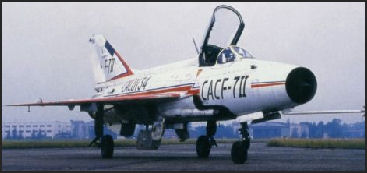
1950s-era jet Others were given jobs in the national railway system. In early September 2007riots and demonstrations broke out in at leaser four cities involving former soldiers upset over poor treatment at retraining facilities operated bu the national railway.
The cuts are part of an effort to make the PLA leaner and meaner and to save money, which can be spent elsewhere such as on high tech equipment. The goal is to create a flexible force built around a core of about five land force divisions, supported by a small navy and a modernized air force. There is an effort to better train and equip a smaller force able to operate high-tech weapons.
China is trying to makes it army more professional by offering incentive to seasoned servicemen to stay longer. It is also trying to attract people with higher education levels. These days you can find fliers, posters and recruiters at China’s top universities trying to get China’s best and brightest to sign up for the military. Many top students sign up to gain experience, learn some discipline, and acquire technical skills and knowledge of advanced technology. Others are attracted by promises of financial help with their university studies and offers of a coveted Beijing residency. To weed out slackers, psychological testing has been introduced. Those who want to be pilots have to pass an English or Russian language test.
China is making an effort to attract more recruits with university degrees raising the enlistment age to 22 and lowering eye test requirements.
Problems with Chinese Military
On paper the Chinese military looks formidable. But in reality the force is bloated and inefficient and the personnel is poorly trained and the technology is antiquated. Many of the troops are barely literate. Large forces are difficult to move due to shortages of trucks and other equipment.
In the old days many peasants singed up for the army because if promises they would receive three meals a day. Many recruits only had a primary school education.
China still has a largely conscript army made up of uneducated peasants that used obsolete Soviet designs form the 1950s. Many of China's weapons are not so much different from those used in the Korean War. Many of China’s tanks, ships and aircraft were designed in the 1950s and 60s based on even older Soviet designs. One military expert told Newsweek that "China's military is 20 to 30 years behind the U.S. There's no signs they are making leapfrogs or the breakthroughs in their own military R&D that would enable them to catch up."
The shortcomings of the Chinese military include poorly-gunned ships, inadequate port facilities that are vulnerable to anti-ship missiles, submarines that can easily be detected by sonar, an air force undermined by politics and outdated planes, and weak integration between the naval, land and air forces. The Chinese military has few weapons made in the 1990s or 2000s in its inventory. These old weapons no match for smart weapons and advanced equipment employed by American forces.
Advanced Technology in the Chinese Military
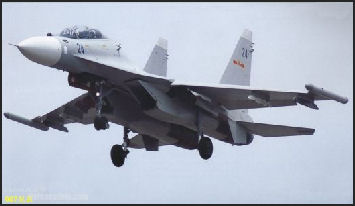
SU-30, newest Russian-made jet
Chinese military technology definitely does not measure up to that of the United States. The Persian Gulf wars were reportedly eye-opening experiences for the Chinese military. Leaders were shocked by the advanced state of the high-tech weaponry and the strategy that went with it and painfully aware of how lacking they were. are. In an effort to catch up China has purchased a lot of advanced weaponry from Russia and has signed an agreement with Russia for the Russians to help the Chinese produce advanced fighters and nuclear-missile-carrying submarines.
.In recent years, the Chinese military has been a making a concerted effort to modernize. It is building and purchasing more advanced weapons and hardware and improvising its electronic and information technology abilities. It is spending heavily to acquire stealthy submarines, advanced fighter jets, computer-guided missiles, satellite-navigation systems and various other kind of high-tech military hardware.
The Chinese have developed an anti-ship ballistic missile that might present a threat to an aircraft carrier and missiles that can be retargeted in mid flight and have over-the-horizon radar capabilities.
China is developing its own homemade AWACS radar planes. It began testing early models of the planes — Russian-made Il-76 transport aircrafts outfit with radar equipment — over the Taiwan Straits in 2004. China feels that having radars planes is crucial to having air superiority over Taiwan. China is also trying to acquire Russian-made Berive A-50 Mainstary radar planes, the equivalent of U.S. Air Force’s E3 Sentry AWACS planes. A plan to purchase Phalco advanced airborne radar system from Israel for $3 billion fell through because of U.S. objections.
The goal is to create a modern force that can use information-based system to mount high intensity military operations as the U.S. did when it invaded Iraq. One U.S. military analyst told Newsweek that the Chinese military is "getting better, no doubt about it. But they've got a long way to go." China is still a generation away from being a major military power.
According to Pentagon report in spring of 2004, China is developing sophisticated missiles, satellite-disrupting lasers and underground facilities — reportedly all aimed at coming out on top in a war with Taiwan.
In a speech in October 2007, Chinese President Hu Jintao said China’s goal ove rthe next five years was “building acomputerized armed forces and wining IT-bases warfare” but insisted that China’s overall goals and intentions were peaceful.
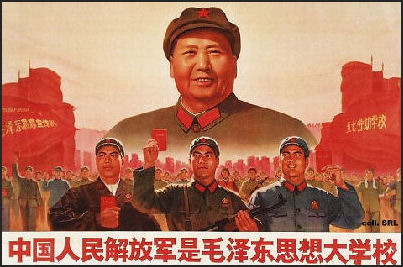
Chinese Military and Politics
Members of the military make up one seventh of 2,217 delegated in national People’s Congress. The single biggest voting block in the meeting. The President si often the head of the military and several generals serve in the Politburo by has no representative in the Standing Committee.
The military is believed to have pressured political leaders in China to enter the Korean War in 1953, invade Vietnam in 1979 and threaten Taiwan in 1996. These days the military is thought to have less sway. Military leader can often be placated with appointments and opportunities A new secessionist law passed in 2005 — which seems bellicose on the service — required the military to get approval of the legislature before making an moves on Taiwan.
Chinese Military and Business
As part of Deng's efforts in 1979 to reform the economy and modernize the military, the military was encouraged to run businesses and make money. Deng made a deal with the military that allowed him to slash troop strength by 20 percent and reduce military budget in return for allowing the military access to the market economy.
The military began by converting military plants to production of consumer goods and starting new businesses like J.J.'s Disco in Shanghai and the Hot Spot Disco in Beijing. By the early 1990s, the military ran companies that produced satellite dishes, cellular phones, beer, trucks, clothing, food, contacts lenses, clocks and other products. Later it began investing in anything in which they saw a potential for profit.
At its peak the People Liberation Army (PLA) managed more than 20,000 commercial enterprises that employed 600,000 people and ran a huge complex of factories that produced 30 percent of China's color televisions, 50 percent of the cameras, 65 percent of the motorcycles and 50 percent of the refrigerators. Its assets included a $1 billion pharmaceutical firm, five-star hotels, Baskin Robbins ice cream franchises and cellular phone services. The PLA even erected a sign in New York's Time Square advertising its "999" stomach medicine.
Factories that made artillery shells were converted to make propane tanks. For a while the Shanghai Aerospace Refrigerator Factory (also known as the Long March Rocket Factory) produced 200,000 refrigerators a year as well as air conditioners, freezers and 140-foot-long, 300-ton Long March missiles. State enterprises or ministries had stakes in highly profitable CD factories that churn out bootleg products. Schools owned businesses that produced textbooks and chairs. In at least one city, local army units help operate a brothel.
Chinese Military Gets Out of Business
Because of widespread corruption and other reasons by the late 1990s Beijing was encouraging the military to get out of business. Increases in military spending are intending n part to take up the slack.
In July 1998, Jiang implemented a directive that stated it was time for the military to get out of business. At that time 50 percent of money-losing, state-owned firms were run by the military and the profit-motive money was eating away at discipline and generating corruption. The plan was expected to involve the selling off of 10,000 to 20,000 companies. One of the big question was how the military would make up for the shortfall in earnings.
Since then the military has largely divested itself of retail businesses but still has some stakes in some businesses. In some case it is difficult to tell how much of a stake they have.
Chinese Military and Corruption
The PLA has a reputation for corruption and has been the focus of anti-corruption efforts. Officers suspected of being corrupt have reportedly been allowed to escape arrest. The one that have been disciplined have ben done so behind closed doors.
In December 2006, a vice admiral was given a life sentence for embezzling $20 million from a military fund and accepting bribes from contractors in exchange for building projects. In January 2007, the head of China National Children Center was sentence to 20 years in prison for taking $30,000 in bribes and embezzling about $100,000. Corruption often goes right to the top. One U.S. expert told Time. "There is probably not a clean family in the entire Politburo."
In 2007, 30 percent of China’s top military officials were audited as part an anti-corruption campaign and warned that any officer that is caught will severely punished.
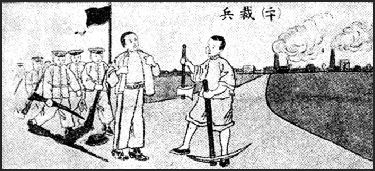
Special Interests and Economic Tie-Ups Expanding with the Military
"As long as the Communist Party stays in power, military expansion in China is sure to continue. This means our business can continue thriving for the foreseeable future." An executive of an equipment supplier to China's People's Liberation Army said this while surrounded by tables covered with bottles of exclusive French wine at a party held for high-ranking officials of state-run enterprises at a swanky hotel in the heart of Beijing in late 2011. [Source: Yomiuri Shimbun, January 26, 2011]
When a guest from another company asked him to explain what he meant, the executive said: "Military expansion has become a kind of vested interest. There are so many people who'll be facing difficult situations unless there's double-digit, year-on-year growth in the national defense budget." Although the executive works at a "private-sector" firm, anyone actually involved in running the company is said to have strong military affiliations. In fact, the company executive is related to a high-ranking military officer. The same guest who questioned the executive noted, "There are quite a lot of companies that have special ties to the military."
China's defense budget in 2011 stood at about $100 billion, up 12.7 percent from the previous year. However, if expenses for military research and development programs are included, the figure may even be double that amount. Thanks to China's rapid economic growth, defense outlays have continued to expand and huge sums of money have poured into a myriad of people with connections to the military via the ammunitions industry.
The web of military organizations led by officers called political commissars has permeated all branches of the military. However, according to a political science scholar in Beijing, "Those who have vested interests in the ammunitions industry have begun to wield great influence over a wide range of fields." He went on to note, "There are even fears that these people could extend their influence to China's diplomatic policy, and thereby erode the Communist Party's control."
One military source said he was alarmed by fears regarding the "retrogression of the Communist Party's control" over the military and ammunitions industry. One of the economic activities the military and state-run enterprises collaborate closely on is a program to explore and develop undersea resources, which can lead to colossal profits if successful. According to findings in a Federation of Chinese Companies survey released last year, state-run companies producing petroleum products ranked first and second in terms of sales, while China National Offshore Oil Corporation, one of China's largest state-run oil resource development companies, ranked 16th with 354.7 billion yuan (about 4.43 trillion yen) in sales.
Image Sources: Landsberger Posters http://www.iisg.nl/~landsberger/; Weapons: Defense Talk
Text Sources: New York Times, Washington Post, Los Angeles Times, Times of London, National Geographic, The New Yorker, Time, Newsweek, Reuters, AP, Lonely Planet Guides, Compton’s Encyclopedia and various books and other publications.
Last updated April 2012
